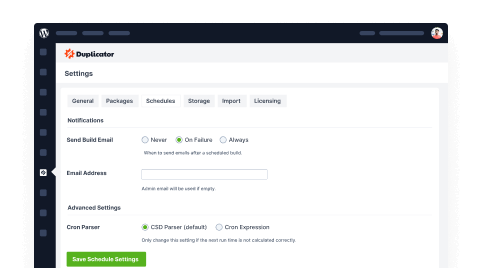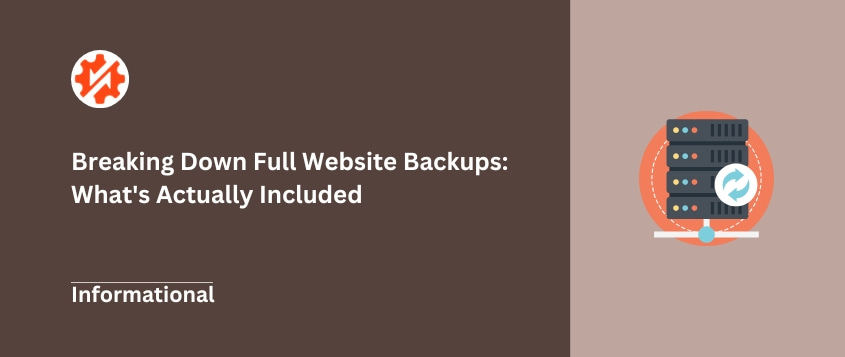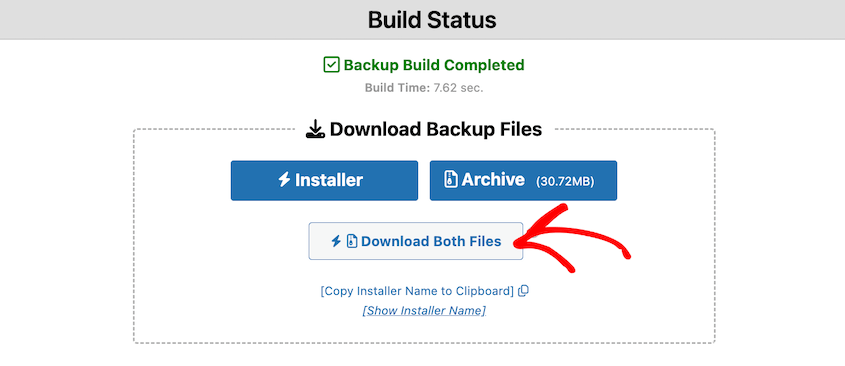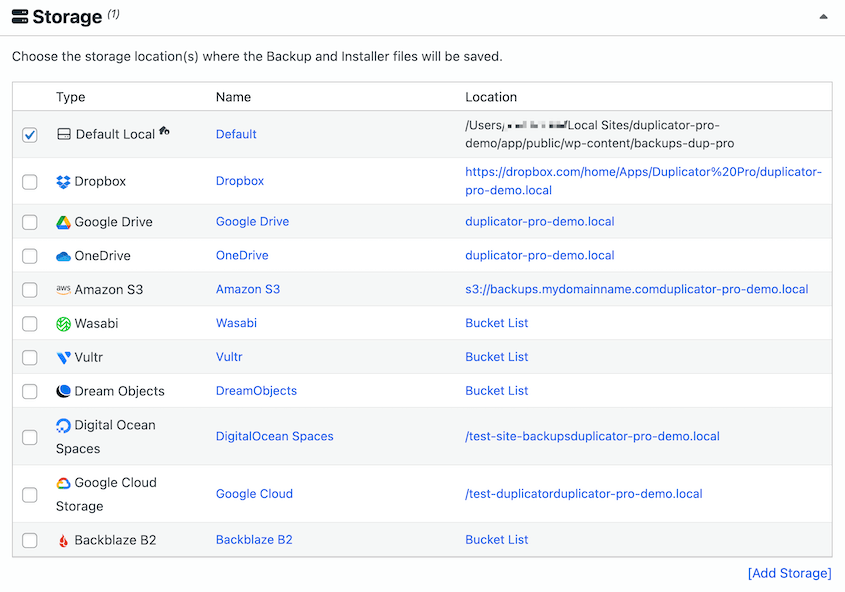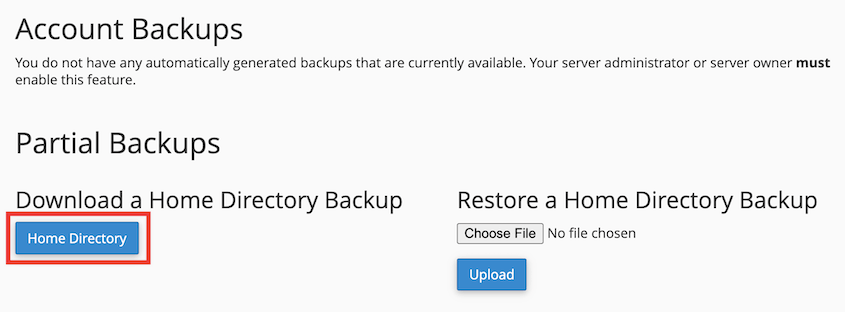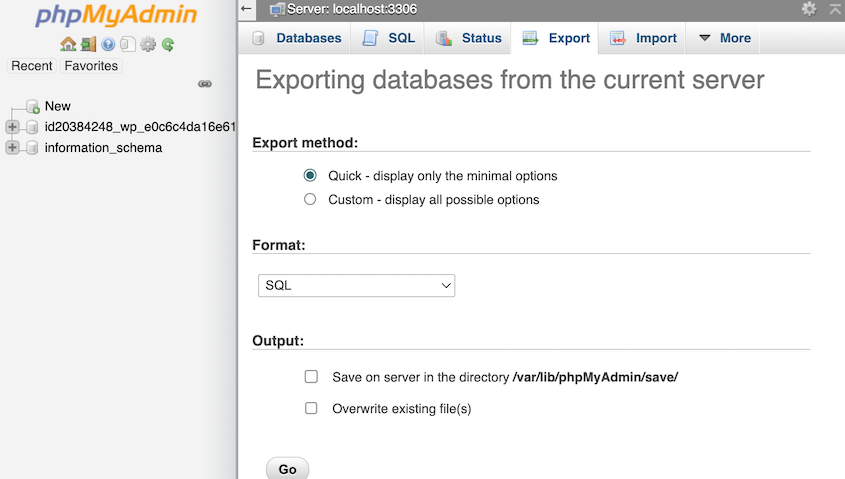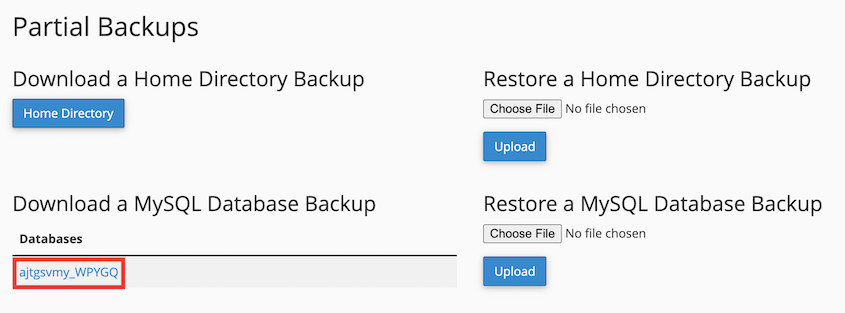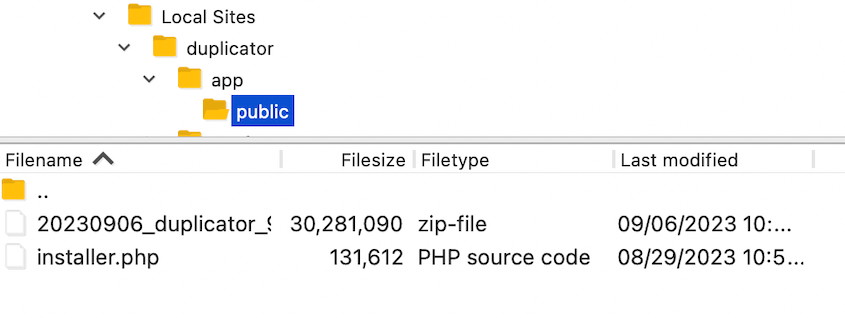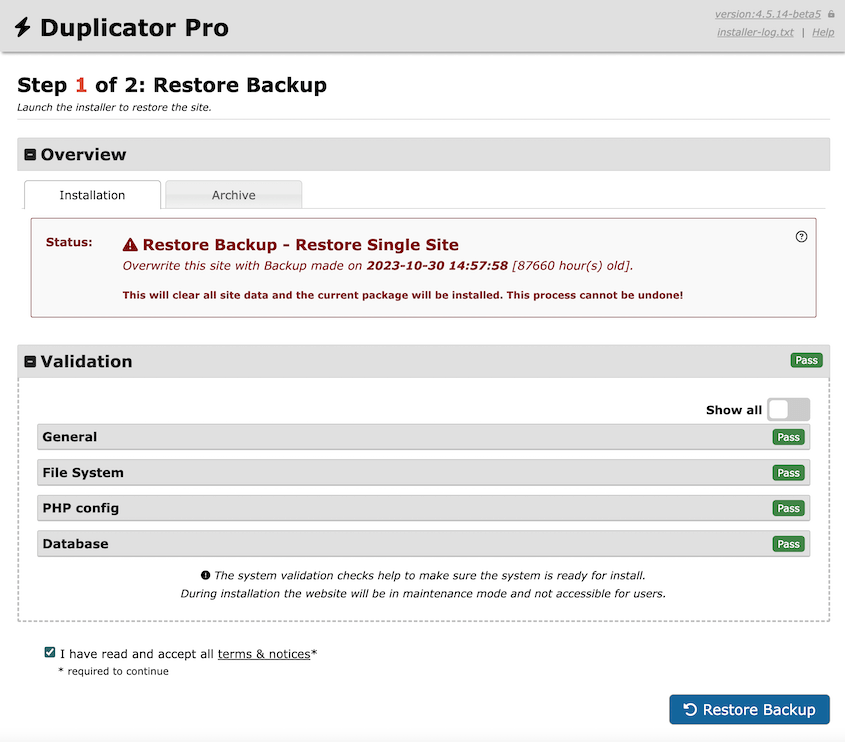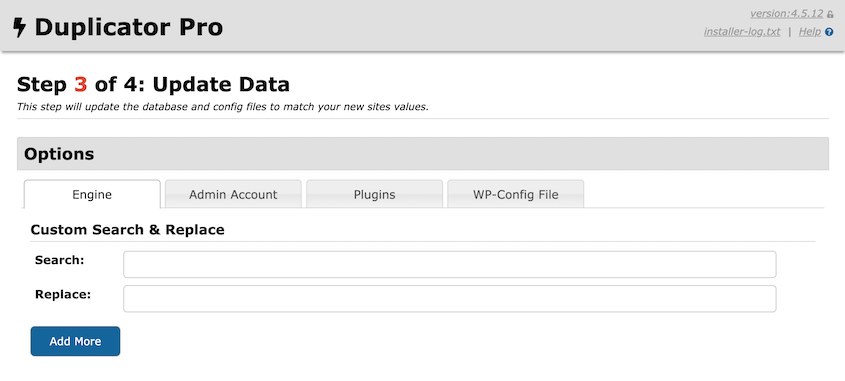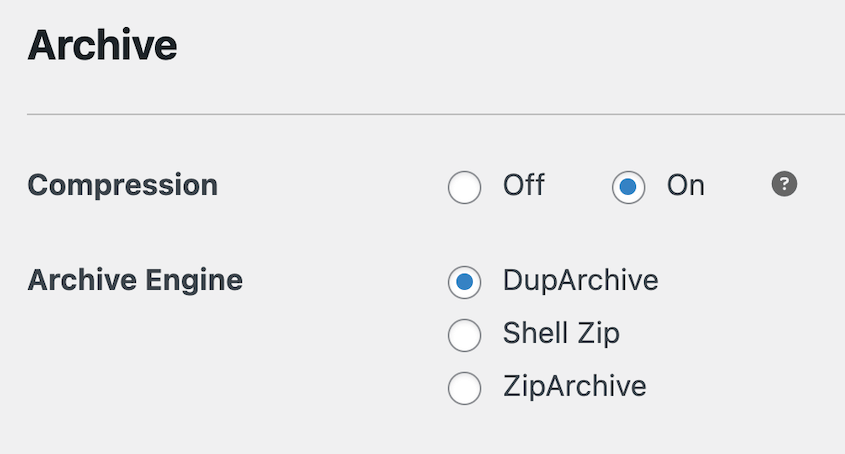The problem isn’t that people ignore backups completely. It’s that they’re doing partial backups without realizing it.
Your hosting provider’s “guaranteed” backups might only cover your database — leaving your themes, plugins, and uploaded files behind.
That popular free backup plugin you installed? It could be missing your configuration files or custom uploads.
Partial protection isn’t protection at all.
When disaster strikes, you need a full website backup that captures every single piece of your WordPress website. Not just the content. Not just the files. Everything.
This post isn’t just about lecturing you on why you need a backup. We’re diving into the practicalities.
You’ll learn what a full website backup truly covers, the smart (and affordable) ways to get one, best practices I’ve learned over the years, and crucially, how to get your site back online fast.
Table of Contents
What Is a Full Website Backup?
A full website backup captures every piece that WordPress needs to recreate your site as it exists right now.
It allows you to take these files to any web server, anywhere in the world, and recreate your website exactly as it was.
This includes two essential components: your WordPress files and database.
In your files, you’ll need your custom themes, plugins (yes, even the inactive ones you’re planning to use later), and your media uploads. You won’t want to lose images, videos, and other content.
Your WordPress database is the heart of your site. It includes your posts, pages, user comments, your site settings, and plugin configurations. Without this, your content is gone.
A full website backup means having a complete, restorable snapshot. Think of it as a clone of your entire WordPress installation at a specific moment in time.
Why a Full Website Backup is Non-Negotiable for Your WordPress Site
When you back up your website properly, full backups allow you to quickly revert to previous stable versions when updates or changes cause problems.
You can undo problematic plugin updates in minutes instead of hours. It’ll be easy to return to working versions while you troubleshoot compatibility issues.
Hackers are always out there, and a compromised site with malware can be a nightmare. A clean backup is often the quickest fix.
We’ve all made mistakes. A wrong click, a deleted file, or a bit of code experimentation can sometimes go sideways.
Sometimes a plugin, theme, or even a WordPress core update doesn’t play nice with your setup. Or, your host could have a hardware failure. It’s rare with good hosts, but it happens.
Full-site backups can fix any of these problems. You can use it to restore all of your data in the blink of an eye.
Full backups aren’t just insurance policies — they’re business tools that enable growth and experimentation.
You can:
- Sleep better knowing that months or years of work won’t vanish overnight.
- Focus on growing your business instead of worrying about data loss.
- Make changes and updates confidently, knowing you can quickly revert if something goes wrong.
- Switch hosting providers without technical headaches or data loss.
- Train team members on exact copies of your real site without breaking something important.
The real cost of not having a full website backup isn’t just the data. It’s lost time, lost potential revenue, damage to your site’s reputation, and the stress of trying to piece things back together.
Good news: you’ve got lots of options for creating a full website backup, and they cater to different comfort levels with tech and different budgets.
We’ll look at the main approaches: plugins, manual methods, and what your hosting provider offers.
Method 1: Full Backups with WordPress Backup Plugins
Before plugins, creating a full backup meant juggling FTP clients, database exports, and hoping you didn’t miss any critical files. One wrong step could leave you with an incomplete backup that fails when you need it most.
Now you can click a button and get a complete, reliable backup in minutes.
Duplicator is my favorite WordPress backup plugin. It approaches backups a little bit differently than most plugins.
Instead of just creating backup files, Duplicator creates complete packages that include custom installer files. This means you can restore your site even when WordPress is completely broken or inaccessible.
All you’ll need to do is create a new backup. Select the Full Site preset.
Every Duplicator backup creates two files: a complete zip file of your site and an installer script. Upload both files to any server, run the installer, and watch it rebuild your site automatically.
The installer adapts to new server environments automatically. No manual database configuration. No path corrections. No technical troubleshooting.
With Duplicator, set up daily, weekly, or monthly schedules once, then forget about them. Backups happen automatically whether you’re sleeping, traveling, or focused on running your business.
You can automatically upload your full backups to Google Drive, Dropbox, Amazon S3, or other cloud services. This will protect you from local server failures.
Other plugins often fail on sites with thousands of images or complex plugin configurations. Duplicator has a custom file format that handles large sites that break other backup solutions.
Method 2: Manually Create Full Backups
Manual backups give you complete control but require technical knowledge and significant time investment.
When you manually back up your site, you’ll need a copy of two things: your site files and database. You’ll need an FTP/SFTP client (like FileZilla or Cyberduck) to download your files.
Connect to your server using credentials from your hosting provider. Download your entire WordPress installation folder to your computer.
You could also download a full backup in cPanel, a file manager provided by your web host. Just download all of the files in your home directory.
This process can take hours for image-heavy sites. Connection timeouts or interruptions can corrupt downloads, forcing you to start over.
For a database backup, access phpMyAdmin through your hosting control panel. Select your WordPress database. Use the Export tab to create a downloadable .sql file.
Choose Quick export for simplicity, though advanced users might prefer custom export options.
Some hosts provide backup wizards that create compressed database files. For example, cPanel allows you to download your database with a click.
The advantage of manual backups is you’ll have complete control over what gets backed up and when. It’ll work on any hosting setup that allows file access. You won’t have ongoing subscription costs from hosting backups or a premium backup service.
On the other hand, it requires technical knowledge of FTP and database management.
It’s easy to forget important files or database tables. No automation — you have to remember to create a backup manually every time.
Method 3: Hosting Provider Full Backups
Many web hosting companies include backup services. This is often a good first line of defense.
These backups are server-level snapshots taken by your host. Backup frequency varies widely — some daily, others weekly or monthly. Retention periods usually range from 7 to 30 days.
Backup services are free with most hosting plans or available as low-cost add-ons. It can be an affordable hands-off option if that’s what you need.
To see what kind of backups your host provides, ask these questions:
- How often are backups taken?
- How long are they kept? (Retention period)
- Are they full website backups that you can download and take elsewhere if needed?
- What’s the process (and cost, if any) to restore a backup?
Although this can be an easy option, it’s not the most reliable. Some hosts exclude certain file types or directories. Backup formats may not be easily portable to other hosting environments.
If you need to restore a hosting backup, you might need to submit support tickets and wait for technical staff.
Restoration requests often take days during busy periods. You’re completely dependent on their timeline and availability.
Your host’s fixed backup schedule may not match your site’s update frequency. Plus, backups are stored on the same servers as your live site, providing no protection against data center failures.
The bottom line: Hosting backups should supplement, never replace, your independent backup strategy.
Hosting companies fail. They go out of business. They lose data. They make mistakes.
You need backups you control, stored in locations you choose, with restoration processes you can execute yourself.
Best Practices for Your Full Website Backup Strategy
Creating full backups is only half the battle. A solid backup strategy protects you consistently over time, not just once.
Backup Frequency: How Often Is Enough?
The right backup frequency depends on how much work you’re willing to lose.
E-commerce stores with frequent orders and inventory changes can’t afford to lose even one day of transactions. News sites and busy blogs publishing multiple times daily create too much new content to risk losing.
If losing one day of work would be painful, back up WordPress content daily.
Stable sites can back up weekly. For example, brochure websites that rarely change don’t need daily protection. Portfolio sites updated monthly or quarterly won’t lose much in a week.
Ask yourself: “How much work am I willing to redo?” Your backup frequency should match your answer. Consider both content creation time and business impact.
Don’t forget that comments, user registrations, and form submissions count as new content worth protecting.
Storage Strategy: The 3-2-1 Rule
Many websites follow the 3-2-1 rule for good reason — it works.
Here’s what to do:
Keep THREE copies of your data.
Your live site counts as copy one. Keep at least two additional backup copies stored separately. More copies mean better protection against simultaneous failures.
Store copies on TWO different types of storage.
Don’t put all backups on the same type of storage device. Mix local storage with cloud storage services.
Use different physical locations when possible. Avoid single points of failure that could wipe out multiple backups at once.
Keep ONE copy off-site.
If your server fails or gets hacked, a backup of your website stored on that same server is useless. So, use cloud storage (Dropbox, Google Drive, Amazon S3, etc.) or download to an external drive.
Automation Eliminates Human Error
Manual backups fail because people forget, get busy, or skip steps during stressful periods.
Automation runs regardless of your schedule, memory, or stress level.
Configure automatic backups to run every hour, day, week, or month. You can also set up different schedules for different content types.
Regular automated backups prevent gaps in your backup timeline. No more discovering that your last backup was three weeks old when disaster strikes!
Test Your Backups Regularly
Here’s the uncomfortable truth: some backups don’t work when you need them.
Problems can happen silently. You could have corrupted backup files, storage issues preventing complete backups, or plugin conflicts creating incomplete archives.
Use a subdomain, staging environment, or local development setup to test your backup tools. Walk through the entire restoration process from start to finish.
Once you restore a backup, verify that all pages load correctly, contact forms work, user logins function, and administrative features operate normally.
Always Back Up Before Major Changes
Never make significant changes without a current backup.
Core updates can break sites with custom code or outdated plugins. Recent backups enable quick rollbacks if compatibility issues arise.
Major version changes carry a higher risk of conflicts or functionality changes. Theme updates may overwrite customizations you’ve spent hours perfecting.
New plugins or themes might conflict with existing software. Design changes can have unexpected consequences across your site.
Any custom development work risks breaking existing functionality. Recent backups provide safety nets for experimentation.
How to Restore Your WordPress Site from a Full Backup
Alright, let’s say the unexpected happens, and you need to restore your full website backup. If you’ve used Duplicator, you’re in a good position.
Duplicator is designed not just for creating backups, but for making the restoration process as straightforward as possible.
Use FTP, SFTP, or your hosting provider’s file manager. Upload both the archive (.zip) and installer (installer.php) files to your domain’s root directory.
Open your web browser and go to yourdomain.com/installer.php. The Duplicator installer starts automatically.
This works even when your WordPress admin area is completely inaccessible!
The restoration wizard walks you through each step with clear instructions. It automatically creates new databases or overwrites existing ones.
No manual database imports or file uploads required. Duplicator manages technical details without requiring server administration knowledge.
One of the great things about Duplicator is that it handles a lot of the tricky bits, like search-and-replace operations in the database if your site URL or file paths are changing.
This is common during migrations or when restoring to a different environment.
You can also easily restore backups when your dashboard is accessible. Select a backup from Duplicator’s log and hit Restore.
This helps you immediately revert recent changes, updates, or configuration problems. It’s much faster than full manual restores.
Full Website Backup FAQs
What is the 3-2-1 rule for backups?
Keep 3 copies of important data — your original live site plus 2 backups stored separately. Store these copies in 2 different storage types or locations to avoid single points of failure. Keep 1 copy off-site for protection against local disasters, data center failures, or regional emergencies.
This industry-standard approach protects against multiple simultaneous failures that could otherwise wipe out your data.
How do I get a full backup?
Use a comprehensive backup plugin like Duplicator to capture both website files and database in a single process. Verify the plugin includes all WordPress components: core files, themes, plugins, uploads, database content, and configuration files.
Test the restoration process to confirm your backups are actually complete and functional.
Consider automated scheduling for regular full backups so you never have to remember to create them manually.
Is it possible to copy an entire website?
Yes, that’s what a full website backup achieves. When you back up a WordPress site completely, it includes all components of your site – WordPress core files, themes, plugins, media, and the database.
Are free backup plugins good enough for a full website backup?
Many free backup plugins offer solid basic functionality for small, simple websites. They’re good starting points if you’re just beginning to implement backup strategies or working with basic sites that don’t change frequently.
However, free plugins typically lack advanced features like automated scheduling and cloud storage integrations.
For business websites, membership sites, or e-commerce stores, premium plugins offer better reliability, automation, and recovery options that justify their cost.
My website is huge! Will my full website backup files be too big?
Large sites do create large backup files, but tools like Duplicator handle this well. It compresses your site’s data into a more manageable zip file. You can also change the file format to DupArchive, a custom format for backing up large sites.
You could also consider incremental backups that capture everything initially, then only save changes in subsequent backups. This dramatically reduces file sizes after the first complete backup.
I trust my hosting provider; they say they do backups. Isn’t that enough?
Host backups are a good safety net, but not sufficient alone. You have no control over their backup procedures, restoration timelines, or data retention policies. Restoration often requires support tickets and waiting periods that can extend your downtime significantly.
Hosting companies fail, lose data, or go out of business more often than most people realize.
Independent backups give you complete control over your data and immediate access when problems occur.
I treat host backups as a secondary measure. My primary strategy always involves my own, independent full website backups stored off-site, over which I have full control.
Secure Your WordPress Future with Full Website Backups
Your website represents more than code and content. It’s months or years of hard work, creativity, and business building.
Data loss doesn’t discriminate. It happens to beginners and experts, small personal blogs, and major e-commerce sites. Server hardware fails, hackers attack, updates break functionality, and people make mistakes.
Full website backups provide complete protection and genuine peace of mind.
Duplicator Pro makes full website backups simple, automatic, and reliable. Join thousands of WordPress users who sleep better knowing their hard work is protected by scheduled backup systems!
Stop leaving your website’s safety to chance.
While you’re here, I think you’ll like these hand-picked resources:
Joella is a writer with years of experience in WordPress. At Duplicator, she specializes in site maintenance — from basic backups to large-scale migrations. Her ultimate goal is to make sure your WordPress website is safe and ready for growth.

